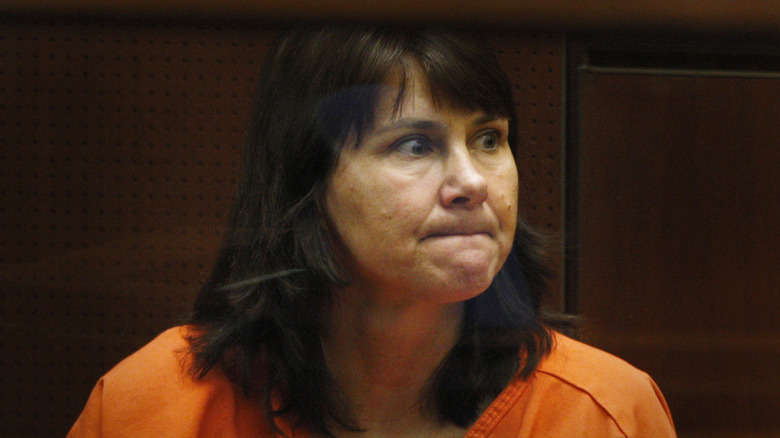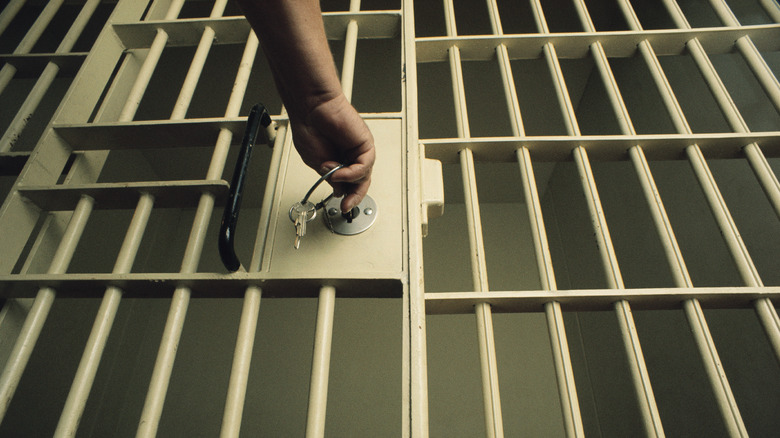Whatever Happened To Convicted Murderer Stephanie Lazarus?
The slaying of Sherri Rasmussen was one of the most disturbing murders of late-1980s California. Her body was discovered by her husband, John Ruetten, in their home in 1986 after she was beaten and shot to death in what appeared to have been a botched burglary that had turned violent. And for many years, it was also one of the most puzzling cases, with investigators managing to make little headway despite what appeared to be a great deal of crime scene evidence.
Rasmussen's murder became a cold case that remained unsolved for 23 years. But in 2009, new technology in the field of forensics allowed investigators to develop a new lead suspect: Stephanie Lazarus, Ruetten's ex-girlfriend. Rather than a burglary, what unfolded was a tale of blind rage and jealousy, from a woman who many following the case were shocked to discover was herself a police officer at the Los Angeles Police Department. Lazarus' trial was a sensation, and her story continues to provoke the public with lurid twists as she attempts to secure her release.
She was arrested in 2009
The 2009 breakthrough in the Sherri Rasmussen murder came after the LAPD finally had the bandwidth to deal with cold cases after many years of high crime rates. It was during this time that investigators began to question the prevailing theory that Rasmussen's killing was the result of a burglary gone wrong. After reexamining the evidence, officials noted several inconsistencies.
The original assumption was that the struggle between Rasmussen and the intruder, who had not expected to find anybody home. However, the front door of the building was not forced open, and a stack of electronic equipment — which had seemingly been piled after the deadly confrontation — appeared to have been positioned to make the scene look more like a botched burglary. A DNA test, which at the time was increasingly used to help solve cold cases, showed a bite mark on Rasmussen's arm had been made by a woman, compelling investigators to draw up a shortlist of female suspects, including Lazarus. She was interviewed and arrested after her saliva from a discarded cup was matched to the bite mark.
Frustratingly, suspicion of Lazarus had first been raised back in the 1980s by Rasmussen's father, Nels, who tried to convince police to investigate John Ruetten's old girlfriend, who was in the police department. He was written off as a fantasist. Nels had also tried to compel detectives to use DNA analysis, which came to prominence in the years following the murder, but the evidence remained unexamined for many years.
She was sentenced to 27 years to life in prison
The trial of Stephanie Lazarus was a major news event, with the media providing ample coverage on account of the shocking details of the case. In particular, that a brutal Los Angeles cold case murder appeared to have been committed by a serving police officer. During the trial, Lazarus, who was allowed to retire from the LAPD after her arrest, was depicted as a scorned lover who grew embittered when her lover, John Ruetten, announced he was to marry someone else. Sherri Rasmussen had been shot three times in the chest, and Lazarus' gun, a .38-caliber Smith & Wesson revolver — which most LAPD cops carried as their backup firearm at the time — was matched to the one used at the scene. Records showed that she reported the weapon missing days after the murder, suggesting that she had disposed of it.
The key evidence, however, was the DNA from the bite mark. Despite the protestations of her defense team, who tried to undermine the evidence with accusations that the sample had been improperly stored and handled, the jury was convinced of the evidence. At the conclusion of her 2012 trial, Lazarus, who had pleaded not guilty but chosen not to take the stand in her own defense, was sentenced to 27 years to life for the murder of Sherri Rasmussen.
Lazarus appealed her conviction
Despite being tied to the murder by a case so strong that the presiding judge imposed a $10 million bail to prevent her fleeing, Stephanie Lazarus and her legal team appealed her murder conviction in 2013. The filing, which ran to 182 pages, raised issues with the amount of time that had passed between the opening of the case and the testing of the DNA samples. The delay, it argued, was negligent and denied Lazarus due process of law. It also claimed that the judge presiding over the trial had been prejudiced in favor of the prosecution, having denied all of the defense's pre-trial motions.
The case came before the Court of Appeal in July 2015. Lazarus' attorney, Donald Tickle, laid out the grounds for reconsideration, and they were rejected by the court. Presiding Justice Nora Manella ruled that the delay was legitimate and said the claim the court was prejudiced in the murder trial was "speculative in the extreme" (per Metropolitan News-Enterprise).
She remained without possibility of parole until 2023
Stephanie Lazarus has remained behind bars ever since her appeal failed to overturn her 2012 murder conviction. She continues to be held at the California Institution for Women in Chino. In 2023, Lazarus became eligible for parole, a development that drew a great deal of attention in the media. It was during her first parole hearing that Lazarus finally publicly admitted her culpability for the crime and expressed what she claimed were feelings of remorse. "It makes me sick to this day that I took an oath to protect and serve people, and I took Sherri Rasmussen's life from her, a nurse," she said in a transcript of the hearing (via CBS News). "I didn't do the right thing because I didn't want to face the consequences of my actions. I didn't want to go to prison."
During this time, the public also got the first insight into Lazarus' life in prison. Notably, inmates who served time alongside the murderer have spoken positively about her. Jane Dorotik, whose own murder conviction was overturned and who now works for the Los Angeles Innocence Project, claimed that Lazarus is a "kind, compassionate and a dedicated individual. "She has taken full responsibility for her actions," Dorotik said. (via the Los Angeles Times). Her supporters, who include a nun and two college professors, have pointed to the rehabilitation work she has undertaken behind bars, as well as her involvement in educational programs and other activities aimed at helping her fellow prisoners.
Her parole hearing has been delayed
Stephanie's Lazarus was initially deemed to be suitable for parole following her first hearing in November 2023. However, news that she may be set free was met with criticism so fierce that the governor's office recommended a reappraisal of the parole board ruling. In a fresh hearing in 2024, during which Lazarus' supporters praised her as a reformed character, relatives of Sherri Rasmussen tearfully reminded the board of the pain that Lazarus had brought to their lives through the murder and her continuing to hide in plain sight in the LAPD for more than two decades. "She lied for decades until her only option was to pursue parole," said Rasmussen's widower John Ruetten, highlighting the premeditated and brutal nature of his wife's murder (via the Los Angeles Times). "Sherri's parents lost her child, and her sisters lost a dear friend and confidante because Sherri loved and married me," he later added. "For me, the reality of the pain never subsides." Testimony was also heard from Rasmussen's father Nels (pictured), her sisters, and nieces.
In response, the California Board of Parole Hearings announced in May 2024 that Lazarus' parole was on hold. In October, she was denied release, NBC News reported. According to a spokesperson for the California Department of Corrections and Rehabilitation, a panel found "good cause" to rescind her parole. Her next hearing will happen within six months as of this writing.





